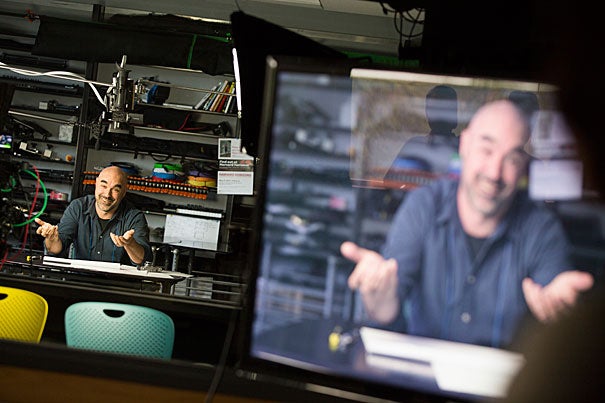
Participants at the fifth annual Harvard Initiative for Learning and Teaching (HILT) conference will work together toward “bite-sized innovations” to promote interactivity in University classrooms.
File photo by Stephanie Mitchell/Harvard Staff Photographer
Sharing the small stuff
Learning-teaching conference a showcase for ‘bite-sized innovations’
Interactivity will be the focus of the fifth annual Harvard Initiative for Learning and Teaching (HILT) conference as faculty, instructors, and academic professionals from all parts of the University gather to discuss best practices, as well as theory and experience, in both learning and teaching.
“When you are in a conversation, when you have to respond, then you are thinking,” said Peter Bol, vice provost for advances in learning at Harvard, who will offer introductory remarks at the conference’s final session. “Interactivity is about being engaged in learning and responding at the same time.”
The topic for the conference, which runs from 8:45 a.m. to 1:45 p.m. on Friday at Wasserstein Hall, was developed in the spring as HILT reached out to faculty over a series of lunch and dinner meetings for input about their educational challenges and trajectories.
“We were stunned by the number of responses,” said Erin Driver-Linn, director of HILT and associate provost of institutional research, noting that more than 500 answered the initial query, and more than 120 attended one of the small-group discussions. The theme of interactivity came out of those conversations, she said. What also emerged were very practicable ideas.
“What are the nudges, something simple I can do in my classes?” recalled Driver-Linn. “What are some bite-sized innovations?”
The conference, which typically draws 300-500 Harvard community members, promotes a University-level dialogue across campuses, allowing participants to share experiences and experimental approaches and strengthen networks. It will kick off with a panel discussion, to be followed by breakout sessions. The concluding panel will focus on increasing opportunities to improve teaching and learning at Harvard.
Physics Professor Matt Schwartz will lead one of the breakout sessions, in which faculty members share their own small-scale teaching innovations. He’s most concerned with quick, easily applicable fixes. “Stuff that doesn’t take rewriting your whole course,” he said. The examples he cited are indeed small, but they can have major repercussions.
“Someone suggested they always have music playing when people enter their classroom,” he said. “Then they turn it off, and it automatically gets people’s attention.”
From his own experience, Schwartz has learned to “ask students before class what they want me to talk about.” This encourages them to think about the course work and do the reading before each class, he said.
Another goal of Schwartz’s session will be to explore how best to communicate such small-scale ideas, so that faculty can share them. “What I find most useful is people telling me what they have gotten from their own practice, their own trial and error in the classroom,” he said.
Carolyn Wood, director of the Strengthening Learning and Teaching Excellence and the Case Program at Harvard Kennedy School, will lead a session on teaching with case studies. “We kind of have a moment now,” said Wood. “Faculty are very engaged in finding new ways to reach their learners, and case studies are great way to teach.”
Although case studies are common in some fields, such as at Harvard Business School, Wood will ask her participants to explore how other disciplines can make use of it — even on a small scale.
“We’ve found we need to make it easy to get started,” she said. “Once faculty try it, they find that students are more engaged, that students do remember not only the learning sessions but also the learning goals. And for faculty it’s challenging and fun.”
While Wood is focusing on case studies, her overall perspective captures the initiative of the conference. While she expects some experimentation and “a little trial and error,” the goal remains the same.
“Teaching well requires continuous improvement,” she said.




